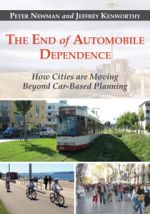The End of Automobile Dependence: How Cities Are Moving Beyond Car-Based Planning

For several decades now, Kenworthy and Newman have been examining the impact of transport on urban sustainability. 1985 saw the publication of Cities and Automobile Dependence, and in the following decade each author published a paper in Environment and Urbanization drawing out this theme. While many policymakers in the 1980s scorned the idea of reducing car use, it has become more acceptable since then to critique car-centred urban planning. Thus the title of the book refers to the current golden age for making cities more amenable to walking, cycling, and using public transport.
The authors identify six key reasons we have reached “peak car use” in cities of high-income countries:
1. Fuel prices
2. Demand for reduced travel time
3. Public transit
4. Density
5. The ageing of urban residents
6. A shift from suburban modes back to urbanism
The trends and interdependencies among these six factors are detailed in the chapters that follow, using the authors’ frameworks as well as historical data.
The data on automobile use patterns span 45 years for 44 high-income cities (given the difficulties of data collection on low-income cities). Figures on changes in car kilometres travelled per unit of GDP, for instance, show that it is no longer the case that wealth leads to car dependence. In fact the reverse is occurring, as economic and lifestyle gains are achieved through a concentration of resources within vibrant cities.
The location-specific data also allow for comparisons between cities. Thus the relatively low density of Australian cities, the high centralization of jobs within European cities, and many other factors are shown to have affected car dependence in different ways, even if the overall trends have been comparable.
The book also debunks the myth that these patterns hold only for wealthy nations. China is an important case. Its car production has peaked, and officials are actively attempting to stem demand for private transport. Such measures in multiple Chinese cities include parking restrictions, auctions for the right to buy a car, and the expansion of metro systems. In China, the link between automobile dependence and both congestion and environmental damage is clear – and is being taken seriously by Chinese planners.
After showing that independence from cars is a real and widespread phenomenon, the authors provide practical suggestions for building upon this momentum. This is one area where the abundance of city examples proves useful: the planning frameworks of different cities are evaluated to show what works and what does not for different types of urban fabrics.
The End of Automobile Dependence is an optimistic book. However, it highlights that what cities around the world are seeing is an end to automobile dependence – automobile use still dominates. What the authors present is a world in which cars are not necessary for every trip, but clearly still have important uses. Ultimately, we are moving in the right direction, as cities that wish to thrive cannot ignore the physical, ecological and economic limits to automobile addiction.
Further reading:
Kenworthy, Jeffrey R (2006), “The eco-city: ten key transport and planning dimensions for sustainable city development”, Environment and Urbanization Vol 18, No 1, pages 67–85, available at http://eau.sagepub.com/content/18/1/67.abstract.
Newman, Peter (1996), “Reducing automobile dependence”, Environment and Urbanization Vol 8, No 1, pages 67–92, available at http://eau.sagepub.com/content/8/1/67.abstract.
Book note prepared by Christine Ro
Search the Book notes database
Our Book notes database contains details and summaries of all the publications included in Book notes since 1993 - with details on how to obtain/download.
Use the search form above, or visit the Book notes landing page for more options and latest content.
For a searchable database for papers in Environment and Urbanization, go to http://eau.sagepub.com/

